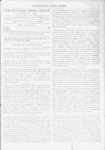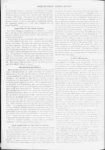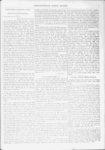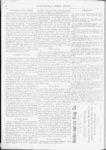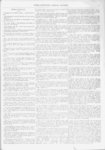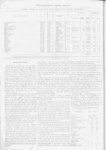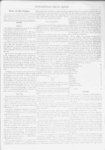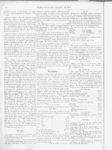| OCR Text |
Show INTER-MOUNTAI- MINING REVIEW. N MINING REVIEW. INTER-MOUNTA- IN AND WESTERN MINING RECORD. Devoted to the Mining: and Smelting Interests of the Published Weekly by Alex Hyslop, 212 Inter-Mounta- in West. Atlas Block. TE11MS: Payable in advance. One Year Six Months $2.00 1,00 50 Three Months To foreign countries except Mexico and Canada, $3 per year, postage prepaid. Entered at the Salt Lake Post office as second-clas- s matter. San Fkancisco Office; 64 and 65 Merchants' Exchange, where this paper is kept on iile. Advertising contracts can by made with E. C. Dake. Agent. Chicago Office: 761 Monadnock Building. SALT LAKE CITY, UTAH Dec. 31, 1896. The Review extends its wishes for a prosperous New Year. The Salt Lake Stock and Mining Exchange commenced doing business one year today, and unlike many other exchanges inaugurated at the same time, it is still doing business. George C. Armstrong, writing from West Australia to the New York Sun, says that wages could be wiped out in the gold mines of that country and then the country wouldnt pay. conference of Canadian Mine Owners and Mining Engineers, will be held in Montreal, February 3, 4 and 5. Already over thirty papers on as many different subjects pertinent to mining have been promised, but the Conference has marked 011b as subjects for special discussion, The Total Abolition of Duty on Mining Machinery, and The Removal of the The Inter-Provinci- al Duty on Explosives. .. - - Railroad operations throughout the United States in the month of November show a decrease in the gross earnings compared with 1895. Out of 127 reporting railroads only 34 show an increase, the highest being the Missouri, Kansas & Texas with $139,894 above the earnings of November, 1S95, while 93 roads experienced actual losses from the months operations, some of them quite material, as in the case of the Chicago, Milwaukee & St. Paul, which was short 8678,179. The reported earnings of these roads for the month was $41,099,000, against $45,652,000 772 for last year, a decrease of 8455300 ant miles more of road in operation. The Chicago & Northwestern sustained a decrease in the month of $607,534 For ie seconc wetek in December seven roads show a total increase of $166,007, while ten roads exhibit decreases aggregating $103,208. In the proceeding issue of the Review an instructive article on the cyanide process, by Professor Ilirsching was published, in which he urges that the study of elementary and analytical chemistry should be extended into the technological processes. The Y ith such a system advantage to be gained would be twofold. c graduation from our American universities would become an standard such as is established by the universities of Europe where the highest excellence is obtained in technological methods. Then the higher education in the natural sciences could be utilized in transforming the natural resources of this country into articles f daily consumption and consequent commercial value. This country abounds in natural resources and raw materials possessing ciuci- high values if subjected to the transforming medium of the acad-emi- 8 ble, but our higher education is not so complete and thoroughin its methods or extent as in Europe. Thus it is that European nations excel in converting all the products of the soil and the mine into materials and articles having a commercial value, while America, with infinitely greater and more varied resources, is a patron of Europe for the finer manufactures, when the same materials could be manufactured here and out of our own products, if the study of chemistry and the other natural sciences was up to the same high standard. The rush for mineral locations out in Rush Valley, and to the west of the outcrop of the West Dip, prompts the query: What are the locators going to do with the ground? If we have been correctly informed, the dip of the West Dip vein, where it is exposed in the Daisy, the La Cigale and the Omaha, is exactly 6o degrees to the west, carrying it out under Rush Valley it is true but at such a pitch that a vertical shaft started at a distance west of the outcrop, equal to the width of the two mineral locations would necessitate a depth of over one thousand feet before the vein could be reached. Of course the vein may flatten out or some other unexpected interruption which would disturb its present dip and bring it nearer the surface, might occur, but present developments are not sufficiently advanced to allow such possibilities to enter into the calculations. In the language of one who is an authority on the entire district, the ore bodies the Wonder, the Hecla and the East Golden Gate are siaking for, are in the grass roots compared with any that will be found half a mile west of the West Dip outcrop. Another modification of the cyanide process for the treatment o refractory ores, is attracting the attention of foreign mining in Africa and Australia where experiments are in progress. It is known as the bromo-cyanidsystem and is the invention of II. L. Sulmm and Dr. Tweed of London, who perfected it two years ago. The system is based on a weaker solution of cyanide of potassium than in the MacArthur or Siemens processes, to which is afterwards added .025 per cent of bromide of cyanogen. The results are said to be remarkable. The gold is dissolved in much less time than with the ordinary methods, and the association of refractory elements such as copper, arsenic and antimony, in no way interferes with or interrupts the dissolution. It is claimed that with the process the necessity of oxygination is dispensed men-particular- ly e with and consequently no time is lost. The gold is almost instantaneously precipitated by adding zinc fume dust to the solution which is kept constantly agitated, and hut a slight quantity of the zinc dust is dissolved, nor is the loss by volitalization in the subseprocess, it is quent smelting material. The bromo-cyanidclaimed, will extract practically all the gold from materials in from fifteen to twenty-fou- r hours, which would require from hour by the other processes. to ninety-siseventy-twe o x Mr. Harry A. Lee, Commissioner of mines in Colorado, has submitted to Governor Mclntire a report of the work of the Bureau since its creation on May 11, 1S95, until November 30th of this year. The report is about the most valuable official paper we have ever read, and if copies of it were placed in the hands of every mine manager and superintendent in the west it would prove a potent agent in reducing the number of mine accidents, A feature of the report is a tabulated statement of the accidents in Colo- ado mines that have been repoited to the Bureau since its crea-ioThe total is 154 men killed and 162 injured. A perusal of the able shows that 84 men were killed and 112 injured in the use of jxplosives after blasting, and of this total inly six fatalities and ive injuries are unaccounh ble. The remainder of the accidents n. |

